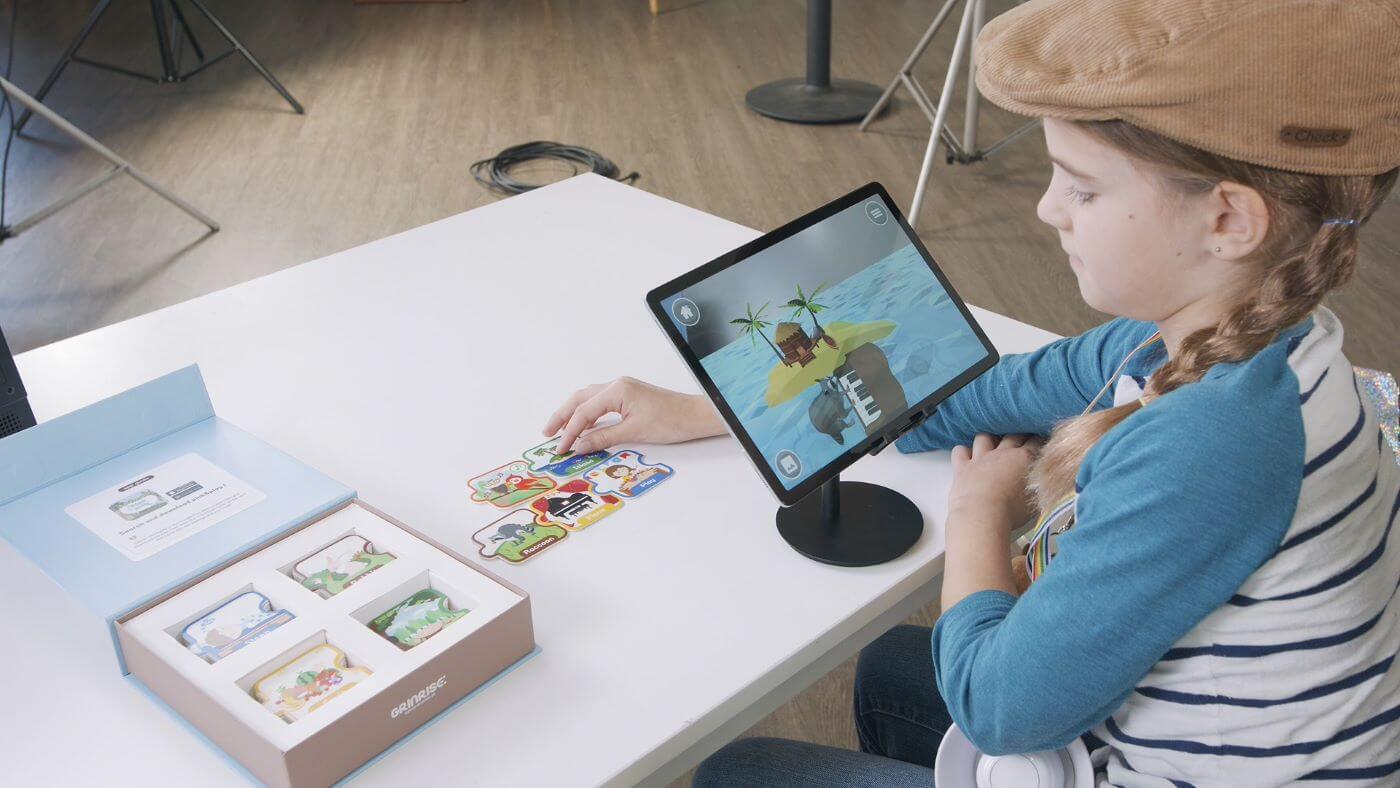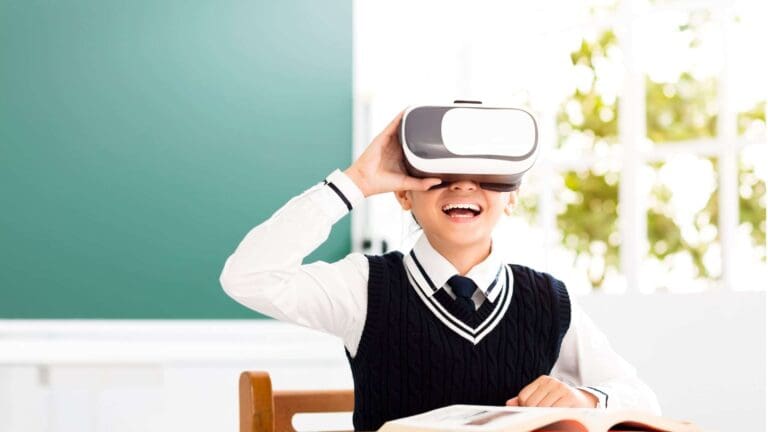Augmented Reality for Kids: Educational Experiences
Augmented reality for kids (AR) has become a powerful tool that can provide educational and entertaining experiences for kids. By blending the real world with virtual elements, AR creates an interactive environment that encourages exploration and discovery. As a parent, you should consider introducing your children to the fascinating world of AR apps and games designed specifically for kids.
From educational apps like CyberChase Shape Quest that helps with spatial awareness to interactive stories and games such as Thomas & Friends Minis, there is an abundance of AR experiences for children to enjoy. With these innovative tools, your kids can develop a love for learning, creativity, and problem-solving in a fun and engaging manner.
When you introduce AR apps and toys to your children, you’re providing them with enjoyable activities and fostering their ability to think critically, adapt to new technologies, and navigate complex settings. Incorporating AR into your child’s playtime could create lasting benefits and invaluable learning experiences for their growth and development.
Why Augmented Reality for Kids
As a parent or educator, you might wonder why augmented reality benefits children. The answer lies in the technology’s ability to transform traditional learning materials and enhance engagement in the learning process.
Through the use of augmented reality, kids can access study materials from anywhere, at any time. This accessibility provides a unique advantage over traditional learning methods, as it allows children to explore and learn at their own pace.
Another significant benefit of augmented reality is its potential to improve engagement and interest in learning. By making education more participatory and gamified, children are more likely to be captivated by the material and retain the information they encounter. This is particularly important, as kids often have a short attention span, making it challenging for educators to hold their attention long enough to facilitate learning.
Augmented reality can also bridge the gap between physical toys and screen-addicted children. Toymakers increasingly utilize augmented reality to create interactive and engaging play experiences that incorporate physical and digital elements.
Furthermore, augmented reality encourages hands-on learning and collaboration. Children can work together on projects, solve problems, and explore concepts in a more interactive way. This fosters the development of essential teamwork and communication skills that will benefit them throughout their lives.
When used responsibly, augmented reality can provide children with a stimulating and engaging learning experience that encourages curiosity, problem-solving, and collaboration.
Benefits of Augmented Reality
Educational Value
Augmented reality (AR) can transform traditional learning materials and methods, making education more interactive and engaging for children. AR enhances learning experiences and encourages students to explore topics more immersively by providing access to study materials anytime and anywhere. This technology can also improve retention and understanding, as it allows children to visualize complex concepts and interact with 3D models.
Creativity Enhancement
AR promotes creativity by blending digital and physical elements, enabling children to experiment with new forms of artistic expression. Through AR apps like Quiver, kids can bring their coloring-in artwork to life, encouraging them to think differently about how their creations can exist in the world. Additionally, AR can inspire children to find new ways to approach problem-solving and creative projects, fostering a sense of innovation and imagination.
Motor Skills Development
AR has the potential to enhance children’s motor skills development as they interact with digital objects and environments. By requiring children to reach, grab, rotate, and manipulate virtual objects, these activities help develop their fine motor skills and hand-eye coordination. When combined with physical movement, AR experiences can also promote gross motor skills development, such as balance and agility.
In summary, augmented reality can offer children a wide range of benefits, including fostering educational value, enhancing creativity, and developing motor skills. By integrating AR into learning and play, you can provide your kids with a richer, more engaging experience that encourages them to think creatively and explore new concepts in a fun and immersive way.
Popular Augmented Reality Apps for Kids
The world of augmented reality offers a fun and interactive way for your children to learn and play. Here are some popular apps that your kids can enjoy.
Zookazam is a fantastic app for animal lovers. It features more than 40 different 3D-rendered animals, including pandas, parrots, rhinos, and velociraptors. By simply aiming your phone, your kids can interact with these animals as they appear to come to life through AR technology.
If your child loves coloring, you should introduce them to Quiver. Quiver allows users to download and print free coloring pages, and once completed, utilizes augmented reality technology to turn the images into 3D animations. This innovative app merges the classic creative act of coloring with modern technology.
For children interested in STEM topics, Immerse – AR in Education is a perfect choice. This content-packed app teaches your kids about STEM concepts through immersive and interactive augmented reality experiences.
The popular Thomas the Train series fans will love Thomas & Friends Minis. In this app, your child becomes a builder, assembling train tracks and creating unique worlds for Thomas and his friends.
These apps are just the beginning of the wide array of augmented reality experiences available for kids. As you continue exploring, you will find many more options to engage and educate your children.

Safety Considerations
When introducing your children to augmented reality (AR), addressing a few safety considerations is important to ensure a positive and secure experience.
Age-Appropriate Content
Just like any other form of media, it’s crucial to ensure that the AR content your child consumes is age-appropriate. To ensure this, monitor the apps and games they use, paying close attention to user reviews, content ratings, and recommended age ranges. Establish a dialogue with your children so they understand the importance of engaging with only suitable AR content.
Privacy and Data Security
AR apps and games may collect data about users, including location information, images, and personal information. It’s essential to be aware of these potential privacy risks and use reputable apps and platforms.
Before allowing your child to use an AR app or game, review its privacy policy and ensure it aligns with your family’s privacy standards. Manage location settings on your child’s device, and educate them about the importance of not sharing personal information with strangers or unfamiliar platforms.
Considering these safety considerations will help create a secure and enjoyable augmented reality experience for your child.
Future of Augmented Reality for Kids
As you explore the world of augmented reality (AR) for kids, it is essential to consider its future potential in various domains such as education, entertainment, and skill development. With tech giants and toy manufacturers on board, the fusion of physical toys, digital experiences, and imaginative play is taking a whole new direction.
AR has immense potential in education to transform traditional textbooks and printed materials into interactive experiences. As a result, students can access study materials anywhere, anytime, and with a higher level of engagement, making learning more participatory and gamified.
Rapid AR technology advancements allow you to offer compelling experiences to kids through various modes, such as marker-based AR and geolocation-based AR, which provide interactive and immersive play experiences.
Moreover, with companies like Disney, Lego, and Hasbro investing in AR, you can expect to see an increased variety of AR toys, games, and activities tailored to meet the needs of children in different age groups.
As you navigate the future course of AR for kids, keep an eye on how technology evolves and integrates with various aspects of children’s lives. The future of AR for kids looks promising and full of innovation that encourages learning, creativity, and real-world interactions.
FAQ
How do you explain augmented reality to a child?
Augmented reality (AR) is a technology that blends the real world with digital elements, like images, sounds, and videos. You can explain it to a child by saying that it’s like putting on a magic pair of glasses that adds fun and interactive elements to the things around them. These digital elements can be viewed and manipulated through devices like smartphones, tablets, and AR glasses, bringing a new level of excitement and engagement to their activities or learning experiences.
Is augmented reality good for kids?
Augmented reality can be a useful tool for kids, especially when it comes to education. It can help transform traditional learning materials, such as textbooks and physical models, into more interactive and immersive experiences. AR has the potential to improve engagement and interest in learning, making educational content more enjoyable and participatory. However, it is essential to regulate the time a child spends using these technologies and ensure that they maintain a balance between screen time and other physical, social, and creative activities.
What is an example of augmented reality for kids?
One popular example of augmented reality for kids is the Seek Education platform. This AR platform provides teachers with resources to encourage interactive learning by overlaying digital content on top of real-world objects. With this technology, students can explore and engage with various subjects fun and innovatively.
What are AR and VR for kids?
AR (augmented reality) and VR (virtual reality) are immersive technologies that add or create digital content in the user’s environment. AR involves adding digital elements, such as images and videos, to the real world, while VR creates entirely virtual environments that users can explore and interact with. Both AR and VR have potential applications for kids in education, entertainment, and even therapy. For example, AR can bring learning materials to life by adding interactive elements, while VR can transport kids to virtual worlds where they can experience new environments, learn new skills, or engage in imaginative play.







